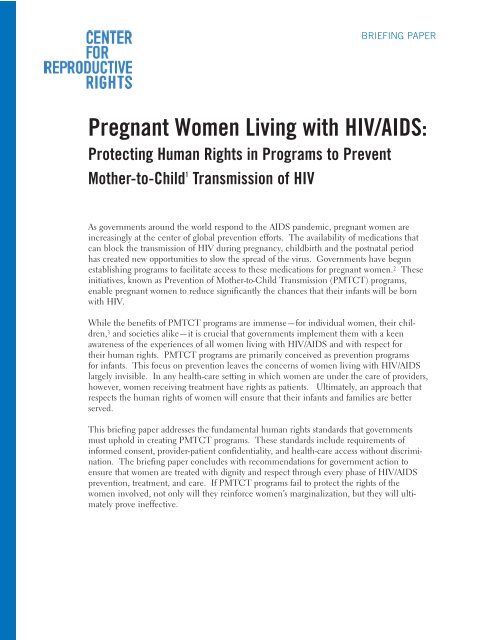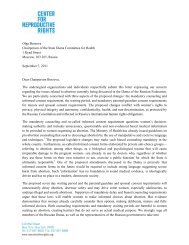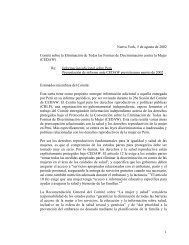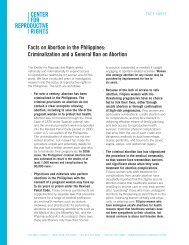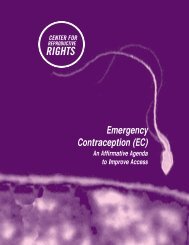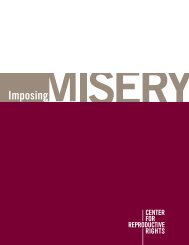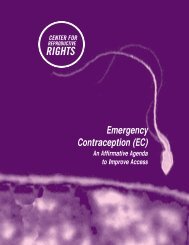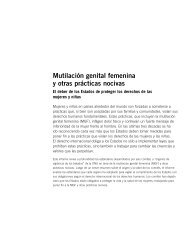Pregnant Women Living with HIV/AIDS: - Center for Reproductive ...
Pregnant Women Living with HIV/AIDS: - Center for Reproductive ...
Pregnant Women Living with HIV/AIDS: - Center for Reproductive ...
Create successful ePaper yourself
Turn your PDF publications into a flip-book with our unique Google optimized e-Paper software.
BRIEFING PAPER<strong>Pregnant</strong> <strong>Women</strong> <strong>Living</strong> <strong>with</strong> <strong>HIV</strong>/<strong>AIDS</strong>:Protecting Human Rights in Programs to PreventMother-to-Child 1 Transmission of <strong>HIV</strong>As governments around the world respond to the <strong>AIDS</strong> pandemic, pregnant women areincreasingly at the center of global prevention ef<strong>for</strong>ts. The availability of medications thatcan block the transmission of <strong>HIV</strong> during pregnancy, childbirth and the postnatal periodhas created new opportunities to slow the spread of the virus. Governments have begunestablishing programs to facilitate access to these medications <strong>for</strong> pregnant women. 2 Theseinitiatives, known as Prevention of Mother-to-Child Transmission (PMTCT) programs,enable pregnant women to reduce significantly the chances that their infants will be born<strong>with</strong> <strong>HIV</strong>.While the benefits of PMTCT programs are immense—<strong>for</strong> individual women, their children,3 and societies alike—it is crucial that governments implement them <strong>with</strong> a keenawareness of the experiences of all women living <strong>with</strong> <strong>HIV</strong>/<strong>AIDS</strong> and <strong>with</strong> respect <strong>for</strong>their human rights. PMTCT programs are primarily conceived as prevention programs<strong>for</strong> infants. This focus on prevention leaves the concerns of women living <strong>with</strong> <strong>HIV</strong>/<strong>AIDS</strong>largely invisible. In any health-care setting in which women are under the care of providers,however, women receiving treatment have rights as patients. Ultimately, an approach thatrespects the human rights of women will ensure that their infants and families are betterserved.This briefing paper addresses the fundamental human rights standards that governmentsmust uphold in creating PMTCT programs. These standards include requirements ofin<strong>for</strong>med consent, provider-patient confidentiality, and health-care access <strong>with</strong>out discrimination.The briefing paper concludes <strong>with</strong> recommendations <strong>for</strong> government action toensure that women are treated <strong>with</strong> dignity and respect through every phase of <strong>HIV</strong>/<strong>AIDS</strong>prevention, treatment, and care. If PMTCT programs fail to protect the rights of thewomen involved, not only will they rein<strong>for</strong>ce women’s marginalization, but they will ultimatelyprove ineffective.
<strong>Pregnant</strong> <strong>Women</strong> <strong>Living</strong> <strong>with</strong> <strong>HIV</strong>/<strong>AIDS</strong><strong>HIV</strong>/<strong>AIDS</strong> and its Toll on <strong>Women</strong>Heterosexual women are the group showing the greatest increases in prevalence of<strong>HIV</strong>/<strong>AIDS</strong>. UN<strong>AIDS</strong> estimates that, in sub-Saharan Africa, women are more likely—atleast 1.3 times—to be infected <strong>with</strong> <strong>HIV</strong> than men. Among younger age-groups, suchas those aged 15–24 years, women are three times as likely to be infected as men. InEastern Europe, rates of infection are rising among women: In Russia, the country inthe region hardest hit by the pandemic, 38% of the newly diagnosed <strong>HIV</strong> cases in 2003were among women, compared <strong>with</strong> 24% in 2001. Asia is also seeing increases in thenumber of women living <strong>with</strong> <strong>HIV</strong>/<strong>AIDS</strong>, <strong>with</strong> <strong>HIV</strong> transmission between spouses becominga more prominent mode of transmission than in the past. In the United States,African-American women account <strong>for</strong> an increasing share of new infections, and <strong>AIDS</strong>has become one of the three leading causes of death among African-American womenaged 35–44.Source: UN<strong>AIDS</strong> & WHO, <strong>AIDS</strong> EPIDEMIC UPDATE DECEMBER 2004 7–9 (2004),available at http://www.unaids.org/wad2004/report.html.I. BackgroundA. DISCRIMINATION AGAINST WOMEN AND <strong>HIV</strong>/<strong>AIDS</strong>Commentators have long pointed to the nexus between <strong>HIV</strong>/<strong>AIDS</strong> and gender discrimination.4 <strong>Women</strong> are physiologically more susceptible than men to <strong>HIV</strong> infection throughunprotected vaginal intercourse, 5 and the vast majority of women living <strong>with</strong> <strong>HIV</strong> areinfected in this way. <strong>Women</strong>’s physiological vulnerability to <strong>HIV</strong> infection is compoundedby pervasive sexual and domestic violence, and by women’s entrenched social andeconomic inequality <strong>with</strong>in their marriages and intimate relationships. 6 <strong>HIV</strong> transmissionbetween spouses is becoming more prevalent and there are indications that marriedwomen have a higher risk of infection than unmarried women. For example, adolescentbrides in some African countries are being infected <strong>with</strong> <strong>HIV</strong> at a higher rate than theirsexually active unmarried counterparts. 7<strong>Women</strong> have also suffered disproportionately from discrimination against people living<strong>with</strong> <strong>HIV</strong>/<strong>AIDS</strong>. The pandemic has led to increased gender-based violence as <strong>HIV</strong>-positivewomen are assaulted, prevented from having children, dismissed from employment,disowned, shunned by their families and communities, and sometimes even killed. 8<strong>Women</strong> are more likely than men to be held responsible <strong>for</strong> spreading the disease and tobe labeled as promiscuous. 9 Fearing violence, stigma, and ostracism, many women avoidtaking <strong>HIV</strong> tests, thereby denying themselves crucial in<strong>for</strong>mation about their health andexcluding themselves from programs to prevent <strong>HIV</strong> transmission to their newborns. 102 August 2005
Protecting Human Rights in Programs to Prevent Mother-to-Child Transmission of <strong>HIV</strong>B. PREVENTION OF MOTHER-TO-CHILD TRANSMISSION OF <strong>HIV</strong> (PMTCT)“When I was found [to be <strong>HIV</strong>] positive, no one talked to me about my well-being.The doctor told me to do MTP [medical termination of pregnancy] as I had no rightto pass on the infection to my baby.”Woman in Mumbai, India, from PANOS & UNICEF, Stigma, <strong>HIV</strong>/<strong>AIDS</strong> andPrevention of Mother-to-Child Transmission (unnumbered page) (2001)available at http://www.ohchr.org/english/issues/hiv/introhiv.htm.PMTCT programs are an ef<strong>for</strong>t to reduce the rate of transmission of <strong>HIV</strong> from a womanto her fetus or newborn during pregnancy, delivery, or the postpartum period. Acrossthe globe, approximately 2.2 million children are currently living <strong>with</strong> <strong>HIV</strong>. 11 Themajor cause of <strong>HIV</strong>/<strong>AIDS</strong> among children is transmission of <strong>HIV</strong> during pregnancy,delivery, and breast-feeding. 12 Infant and child mortality has noticeably increased inmany sub-Saharan countries due to <strong>HIV</strong> infection—both as a direct result of verticaltransmission (which increases child morbidity), and as a consequence of the generalimpact of <strong>HIV</strong>-related deaths on the health-care delivery system. 13In the absence of treatment, an infant’s risk of acquiring <strong>HIV</strong> from a mother living<strong>with</strong> <strong>HIV</strong>/<strong>AIDS</strong> ranges from 15% to 30% among women who do not breast-feed theirinfants. 14 The risk of transmission increases when a woman has a higher viral load(e.g., she is newly infected <strong>with</strong> <strong>HIV</strong> or is at an advanced stage of the disease), or ifan infant is directly exposed to the mother’s infected body fluids during birth. 15 If aninfant born to an <strong>HIV</strong>-positive mother does not contract the virus during pregnancy orchildbirth, studies estimate that the child has a 5–20% chance of acquiring the virusfrom the mother’s milk if he or she is breastfed. 16PMTCT programs have been scaled up as quickly as possible to prevent the tragedyof children contracting <strong>HIV</strong> from their mothers, either in utero, during childbirth, orthrough breast-feeding. PMTCT programs attempt to prevent transmission of <strong>HIV</strong>through the following strategies:a) preventing <strong>HIV</strong> infection among all people, particularly among women ofchildbearing age (through promoting <strong>HIV</strong>/<strong>AIDS</strong> education, expanding condomaccess, and improving women’s status);b) preventing unwanted pregnancies among <strong>HIV</strong>-positive women (through familyplanning and improved reproductive health services); andc) reducing the transmission of <strong>HIV</strong> during pregnancy, childbirth, and thepostpartum period (via the provision of antiretrovirals, safe delivery practicessuch as cesarean sections, and support and counseling on infant-feedingmethods). 17The third strategy is the most common approach used by programs that specificallyfocus on pregnant women living <strong>with</strong> <strong>HIV</strong>/<strong>AIDS</strong>.www.reproductiverights.org 3
<strong>Pregnant</strong> <strong>Women</strong> <strong>Living</strong> <strong>with</strong> <strong>HIV</strong>/<strong>AIDS</strong>Since 1994, clinical trials in several countries have shown that the transmission rateof <strong>HIV</strong> can be drastically reduced through the administration of a short course of thedrug zidovudine to pregnant women and their infants. More recently, a 1999 study inUganda showed that nevirapine could also be used to decrease mother-to-child transmission,and that it is similar in effectiveness to zidovudine. 18 The potential <strong>for</strong> thereduction of mother-to-child transmission is considerable: Antiretroviral prophylaxisaround the time of delivery, <strong>for</strong> example, can reduce transmission two-fold in breastfeedingpopulations. 19 With the adoption of these antiretroviral treatments, motherto-childtransmission rates have declined in the United States and other industrializedcountries to 2%. 20Many countries are currently implementing PMTCT pilot projects or programs.Recent international initiatives have increased the number of PMTCT programs inthe Eastern and Southern parts of Africa and have established additional programsin the Caribbean, parts of Western and Central Africa, parts of Eastern Europe, andparts of Central and Southeast Asia. 21 However, many countries still do not havePMTCT programs, and those that do have experienced difficulty in increasing accessto PMTCT services. 22 For example, 34% of <strong>HIV</strong>-positive pregnant women in Botswanaget PMTCT treatment—a statistic on the higher end—while only 0.1% of <strong>HIV</strong>-positivepregnant women in Guyana do. 23 Only an estimated 1% of <strong>HIV</strong>-positive pregnantwomen in countries heavily affected by the <strong>HIV</strong>/<strong>AIDS</strong> pandemic have access toPMTCT services. 24II. PMTCT Programs and <strong>Women</strong>’s Human Rights“Where individuals and communities are able to realize their rights—toeducation, free association, in<strong>for</strong>mation and, most importantly, nondiscrimination—thepersonal and societal impact of <strong>HIV</strong> and <strong>AIDS</strong> are reduced.…The protection and promotion of human rights are there<strong>for</strong>e essential inpreventing the spread of <strong>HIV</strong> and to mitigating the social and economic impact ofthe pandemic.”Office of the United Nations High Commissioner <strong>for</strong> Human Rights, <strong>HIV</strong>/<strong>AIDS</strong> and HumanRights at http://www.ohchr.org/english/issues/hiv/introhiv.htm (last visited July 28, 2005).PMTCT programs implicate certain fundamental human rights regarding liberty,security of person, privacy, health, and freedom from discrimination. 25 These rightsare undermined where women are denied the opportunity to give in<strong>for</strong>med consent to<strong>HIV</strong> testing and treatment, where their confidentiality is not respected, and where theirinvolvement in PMTCT programs serves to rein<strong>for</strong>ce discrimination and stigma associated<strong>with</strong> <strong>HIV</strong>/<strong>AIDS</strong>.4 August 2005
Protecting Human Rights in Programs to Prevent Mother-to-Child Transmission of <strong>HIV</strong>A. INFORMED CONSENT“The people in charge of the program [to prevent mother-to-child transmission]tell us not to give all the in<strong>for</strong>mation [because they say it might confuse women].Maybe 2% [of the women] are given all the in<strong>for</strong>mation. In fact, the other daythere was a [pregnant] woman who said to me ‘For my child, I will do anything.But they have to give me all the in<strong>for</strong>mation.’ ”Human Rights Watch interview <strong>with</strong> <strong>HIV</strong>/<strong>AIDS</strong> counselor [name <strong>with</strong>held] at a publichospital, Santiago, Dominican Republic, January 19, 2004, Human Rights Watch, A Test ofInequality: Discrimination against <strong>Women</strong> <strong>Living</strong> <strong>with</strong> <strong>HIV</strong> in the Dominican Republic30 (2004) available at http://hrw.org/reports/2004/dr0704/dr0704.pdf (last visited June 16, 2005).Respect <strong>for</strong> an individual’s right to give in<strong>for</strong>med consent derives from the concept ofphysical integrity, which is <strong>for</strong>mally protected in guarantees of the rights to securityof the person, 26 liberty, 27 privacy, 28 and health. 29 <strong>Women</strong>’s right to physical integrityrequires that their decisions regarding health interventions—<strong>HIV</strong> testing and treatmentamong them—be respected. And to make appropriate decisions about their health,women must have access to reliable in<strong>for</strong>mation about the proposed treatment or testingprotocol.In its resolution on the rights of persons <strong>with</strong> mental illness, the United NationsGeneral Assembly defines in<strong>for</strong>med consent as consent to a medical intervention thatis “obtained freely, <strong>with</strong>out threats or improper inducements.” 30 Be<strong>for</strong>e giving consent,a patient must be provided <strong>with</strong> “adequate and understandable in<strong>for</strong>mation in a <strong>for</strong>mand language understood by the patient” on matters such as the purpose of the treatment,alternative treatments and “possible pain or discom<strong>for</strong>t, risks and side-effects ofthe proposed treatment.” 31 Further, the United Nations Committee on the Eliminationof Discrimination against <strong>Women</strong> discusses the right to in<strong>for</strong>med consent in connection<strong>with</strong> article 12, the article on health, in the Convention on the Elimination of AllForms of Discrimination against <strong>Women</strong>. The committee expresses this right as follows:“<strong>Women</strong> have the right to be fully in<strong>for</strong>med, by properly trained personnel, oftheir options in agreeing to treatment or research, including likely benefits andpotential adverse effects of proposed procedures and available alternatives.” 32In<strong>for</strong>med consent must be guaranteed prior to testing and treatment <strong>for</strong> <strong>HIV</strong>/<strong>AIDS</strong>.Counseling should be part of every woman’s decision to learn her <strong>HIV</strong> status and participatein PMTCT programs.www.reproductiverights.org 5
<strong>Pregnant</strong> <strong>Women</strong> <strong>Living</strong> <strong>with</strong> <strong>HIV</strong>/<strong>AIDS</strong>1. TESTING AND INFORMED CONSENT“If [a woman] finds herself <strong>HIV</strong>-positive, she is signing three deaths: psychologicaldeath, social death, and later physical death. Don’t you think that is a lot?”Woman in Koudougou, Burkina Faso, from PANOS & UNICEF, Stigma, <strong>HIV</strong>/<strong>AIDS</strong>and Prevention of Mother-to-Child Transmission (unnumbered page) (2001)available at http://www.ohchr.org/english/issues/hiv/introhiv.htm.As programs to prevent mother-to-child transmission of <strong>HIV</strong> become increasinglyavailable, there is a strong incentive to raise enrollment in those programs by scalingup <strong>HIV</strong> testing of pregnant women.UN<strong>AIDS</strong> and WHO define four different types of testing and categorizethem by whether the testing is initiated by the client (voluntary testing) orthe provider (diagnostic testing, routine offer of testing to all clients, andmandatory testing).• Voluntary testing refers to testing at the patient’s request.• Diagnostic testing refers to testing that is indicated whenevera patient show signs or symptoms consistent <strong>with</strong> <strong>HIV</strong>-relateddiseases or <strong>AIDS</strong>.• Routine offer of testing refers to testing that is offeredwhenever a patient is being assessed <strong>for</strong> sexuallytransmissible infections, when a pregnant patient is seen inthe context of enrollment in a PMTCT program, or a patientis seen in a health-care setting where <strong>HIV</strong> is prevalent andantiretroviral treatment is available.• Mandatory testing refers to testing that is compulsory.UN<strong>AIDS</strong> and WHO discuss mandatory testing only <strong>for</strong> testingblood to be used <strong>for</strong> transfusions or the manufacture ofblood products, and in rare circumstances where a patient isunconscious, where his or her guardian or parent is absent,and <strong>HIV</strong>-status is needed <strong>for</strong> optimal treatment.Expanding women’s access to <strong>HIV</strong> testingduring pregnancy is a necessarycomponent of any campaign to preventmother-to-child transmission. It is crucial,however, that ef<strong>for</strong>ts to increasetesting be complemented by similarcommitments to pretest counseling.Governments should not lose sight ofeach woman’s right to make in<strong>for</strong>meddecisions about her health care, includingher decision to learn her <strong>HIV</strong> status.Where women are <strong>for</strong>ced to takean <strong>HIV</strong> test or are tested <strong>with</strong>out theirknowledge and in<strong>for</strong>med consent, theirbasic human rights are severely compromised.Compulsory <strong>HIV</strong> testing, the mostobvious threat to the right to in<strong>for</strong>medconsent, “can constitute a deprivationof liberty and a violation of the rightto security of person,” according to theInternational Guidelines on <strong>HIV</strong>/<strong>AIDS</strong>and Human Rights, promulgated tohelp states translate human rights principlesinto concrete practices in thecontext of <strong>HIV</strong>/<strong>AIDS</strong>. 33 The guidelineswarn that “there is no public health justification <strong>for</strong> such compulsory <strong>HIV</strong> testing”as “[r]espect <strong>for</strong> the right to physical integrity requires that testing be voluntary and thatno testing be carried out <strong>with</strong>out in<strong>for</strong>med consent.” 34 UN<strong>AIDS</strong> further maintains thattesting can be conducted only <strong>with</strong> in<strong>for</strong>med consent—consent that is both in<strong>for</strong>medand voluntary. 35Source: UN<strong>AIDS</strong> & WHO, Policy Statement on <strong>HIV</strong> Testing (2004), available athttp://www.unaids.org/html/pub/una-docs/hivtestingpolicy_en_pdf.htm.6 August 2005
Protecting Human Rights in Programs to Prevent Mother-to-Child Transmission of <strong>HIV</strong>Even where not compulsory, routine provider-initiated testing, which has beenincreasingly supported as a means to ensure higher rates of testing among pregnantwomen, 36 may threaten women’s right to give in<strong>for</strong>med consent. Though UN<strong>AIDS</strong> andWHO maintain that “<strong>for</strong> provider-initiated testing…patients retain the right to refusetesting, i.e., to ‘opt-out’ of a systematic offer of testing,” many physicians erroneouslybelieve that provider-initiated testing, specifically routine testing, does not require themto seek in<strong>for</strong>med consent. 37 Similarly, many women—particularly those who are youngor who lack financial resources and access to education—may not understand thatthey have a right to refuse testing. 38 Full consent is called into even greater questionwhen the first time women are offered testing is during labor and delivery, as happensin many countries to women who do not receive prenatal care. 39 The stress and painof childbirth can make it difficult <strong>for</strong> any woman to consider fully the implicationsand potential consequences of <strong>HIV</strong> testing. In these ways, “opt-out” testing becomesindistinguishable from mandatory testing, as women are routinely tested <strong>with</strong>out theirfull knowledge or consent. Characterizing a medical test as “routine” does not affecthealth professionals’ obligation to seek in<strong>for</strong>med consent from the women who arebeing tested. 40In the Dominican Republic, women’s human rights are regularly violated whenit comes to <strong>HIV</strong> testing and treatment, according to a report from Human RightsWatch. Several women reported that doctors and other health-care professionalsrequired <strong>HIV</strong> tests as a condition <strong>for</strong> receiving services. In public facilities offeringprenatal care, women received little or no counseling prior to being tested <strong>for</strong> <strong>HIV</strong>.Source: HUMAN RIGHTS WATCH, A TEST OF INEQUALITY: DISCRIMINATION AGAINST WOMEN LIVING WITH <strong>HIV</strong> IN THEDOMINICAN REPUBLIC 29 (2004) available at http://hrw.org/reports/2004/dr0704/dr0704.pdf.If provider-initiated testing of women seeking prenatal care is to become the norm, itmust be coupled <strong>with</strong> comprehensive measures to ensure that <strong>HIV</strong>-positive womenand girls have the opportunity to give in<strong>for</strong>med consent. First, testing protocols mustensure that the offer to test is prefaced <strong>with</strong> an offer of pretest counseling. Once apatient has agreed to be counseled, she should be in<strong>for</strong>med of the benefits of <strong>HIV</strong>testing, the right to refuse testing, the availability of follow-up services, and, in thecase of a positive test result, the implications of that result <strong>for</strong> the patient’s partner orfamily. 41 Following counseling, providers must ensure that the patient has sufficienttime to consider whether or not to undergo testing. Under no circumstance should theprovision of prenatal care be conditioned on <strong>HIV</strong> testing. Once the patient has given aclear indication that she consents to be tested, the screening can take place. Providersshould make referrals <strong>for</strong> posttest counseling on <strong>HIV</strong> prevention and, <strong>for</strong> those who testpositive, <strong>for</strong> medical and psychosocial support. 42www.reproductiverights.org 7
<strong>Pregnant</strong> <strong>Women</strong> <strong>Living</strong> <strong>with</strong> <strong>HIV</strong>/<strong>AIDS</strong>Governments that embrace provider-initiated testing should not abandon ef<strong>for</strong>tsto promote patient-initiated voluntary counseling and testing models. In addition,provider-initiated testing should not be reserved <strong>for</strong> pregnant women only. Where <strong>HIV</strong>infection carries stigma and there is resistance to testing in the general population,targeting pregnant women <strong>for</strong> testing may only marginalize them further, while theirpartners may refuse testing themselves. As UN<strong>AIDS</strong> and WHO recommend, all patientsin a setting where <strong>HIV</strong> is prevalent and antiretroviral treatments are available should beoffered <strong>HIV</strong> testing and counseling. 432. TREATMENT AND INFORMED CONSENTPMTCT programs must provide pregnant women <strong>with</strong> the opportunity to decide freelywhether to accept antiretroviral therapy. The standard <strong>for</strong> in<strong>for</strong>med consent to PMTCTtreatment must abide by the general standard <strong>for</strong> consent as laid out above—i.e.,in<strong>for</strong>med consent is consent to a medical intervention that is “obtained freely, <strong>with</strong>outthreats or improper inducements.” 44 PMTCT programs, as their name indicates, focuson prevention. As a result, the fact that <strong>HIV</strong>-positive women are patients receiving ahealth service is frequently overlooked. These programs must not disregard their duty ofcare to the woman being treated, as well as the rights of these women as patients. In allcases, adequate counseling must be a precondition to women’s participation in PMTCTprograms.To ensure an in<strong>for</strong>med decision, women must be counseled on the risks and benefitsof taking antiretroviral medication, both <strong>for</strong> themselves as patients and <strong>for</strong> their fetusesand infants. They must also receive in<strong>for</strong>mation on the risks and benefits of alternativesto breast-feeding, as well as the likelihood of transmission of <strong>HIV</strong> to their fetus ornewborn, both <strong>with</strong> treatment and in the absence of treatment. Furthermore, womenmust be in<strong>for</strong>med of the fact that although drug therapy may reduce the risk of verticaltransmission, it does not eliminate that risk. 45 This in<strong>for</strong>mation is important because itallows pregnant women to have realistic expectations of how they (and their fetus) mightbenefit from drug therapy.In<strong>for</strong>med consent to undergoing antiretroviral therapy to reduce mother-to-childtransmission is also important because the treatment may affect the health of thepregnant woman. The long-term side effects of temporary exposure to nevirapine orzidovudine must be further researched, as previous studies have shown that there isa small chance of resistance to these drugs—especially after their use during morethan one pregnancy. Researchers state that the risks of antiretroviral treatments areoutweighed by their benefits in preventing mother-to-child transmission of <strong>HIV</strong>. 46However, pregnant women must be fully in<strong>for</strong>med of the medical uncertainties andpotential risks involved. Recent news articles have revived this debate <strong>with</strong> reports thateven one dose of nevirapine during pregnancy can cause resistance, thus underminingef<strong>for</strong>ts to treat <strong>HIV</strong>-positive women <strong>with</strong> the drug after childbirth. 47 It is clear that the8 August 2005
Protecting Human Rights in Programs to Prevent Mother-to-Child Transmission of <strong>HIV</strong>full implications of administering drugs to pregnant women to reduce transmission of <strong>HIV</strong>are not yet known.Finally, pregnant women should be aware that their access to medication may be dependentupon their participation in a PMTCT program. As presently conceived, most PMTCTprograms are aimed solely at protecting the health of fetuses and newborns, 48 rather thantreating women living <strong>with</strong> <strong>HIV</strong>/<strong>AIDS</strong>. It is important that pregnant women understand,through counseling, that access to antiretrovirals may end shortly after they have given birth.As noted by UN<strong>AIDS</strong>:“The fact that antiretrovirals can serve two separate purposes—as [a] vaccine <strong>for</strong>infants against MTCT [mother-to-child transmission] of <strong>HIV</strong>, and as treatment <strong>for</strong><strong>HIV</strong> infected individuals—is, of course, very significant. But the issue of antiretroviraltreatment <strong>for</strong> infected people must be considered separately from the issue ofantiretroviral drugs used <strong>for</strong> the prevention of MTCT. It requires debate and policydecisions outside the scope of MTCT policy-making.” 49Each woman has the right to understand the advantages and risks of getting tested andenrolling in a PMTCT program, and the decision to be tested and enroll should be herdecision alone. A woman who refuses to be tested <strong>for</strong> <strong>HIV</strong> or participate in a PMTCTprogram should not be subjected to punitive action or denial of care, 50 as happened, <strong>for</strong>example, to an <strong>HIV</strong>-positive woman in the United States who had her parental rightssuspended when she insisted on breast-feeding her child. 51B. CONFIDENTIALITY OF CARE“When the patient comes to our ward, it’s written on the file ‘<strong>HIV</strong>’ in bigletters. Anybody can see it. It’s kept next to the patient. Anybody cansee it.”Ward-boy working in a private hospital in Mumbai, India, UN<strong>AIDS</strong>, <strong>HIV</strong> and<strong>AIDS</strong>-Related Stigmatization, Discrimination and Denial: Forms, Contexts andDeterminants, Research Studies from Uganda and India 24 (2000) available athttp://www.unaids.org/html/pub/publications/irc-pub01/jc316-uganda-india_en_pdf.pdf.Privacy and confidentiality guarantees are essential <strong>for</strong> PMTCT programs to effectivelyprotect and promote women’s human rights. For many women, the fear of disclosure oftheir <strong>HIV</strong> status prevents them from seeking health services. The stigma attached to <strong>HIV</strong>can lead to severe consequences <strong>for</strong> women, such as abandonment by partners, rejection byother family members, blame <strong>for</strong> bringing the disease into the family, eviction, loss of economicsupport, physical and emotional abuse, and other <strong>for</strong>ms of discrimination. 52The right to privacy is upheld in many international legal instruments, including theInternational Covenant on Civil and Political Rights. 53 In the context of health status and<strong>HIV</strong>/<strong>AIDS</strong>, the Programme of Action of the International Conference on Population andwww.reproductiverights.org 9
<strong>Pregnant</strong> <strong>Women</strong> <strong>Living</strong> <strong>with</strong> <strong>HIV</strong>/<strong>AIDS</strong>Development states that governments should “ensure that the individual rights and theconfidentiality of persons infected <strong>with</strong> <strong>HIV</strong> are respected.” 54 The International Guidelineson <strong>HIV</strong>/<strong>AIDS</strong> and Human Rights call on states to enact general confidentiality and privacylaws, ensuring that <strong>HIV</strong>-related in<strong>for</strong>mation is protected. 55Health-care providers play an essential role in protecting patients’ privacy. The EthicalCommittee of the International Federation of Gynecology and Obstetrics (FIGO) states thatphysicians have an obligation to “respect and guard the individual patient’s right to privacyand the confidentiality of their health in<strong>for</strong>mation. This includes avoiding the casual sharingof any in<strong>for</strong>mation about individual patients in any setting.” 56In Ukraine, when pregnant women were found to be <strong>HIV</strong>-positive during routine prenatalblood tests, many reported that nurses would disclose their status to other members of theircommunity. 57 As a result, many women would be subjected to abuse, rejection, and abandonment,and a number were <strong>for</strong>ced to leave their homes. 58 Similarly, it has been reportedin Mumbai, India that health-care workers, when they learn that a woman has tested positive<strong>for</strong> <strong>HIV</strong>, insist on disclosing this in<strong>for</strong>mation to the woman’s husband in the belief thatthe woman herself will not understand. 59 The in<strong>for</strong>mation is sometimes shared <strong>with</strong> otherfamily members, as well. 60Breaches of confidentiality may also be indirect. FIGO notes that “the title of a clinic orinstitution may inadvertently breach a patient’s right to confidentiality.” 61 A woman whohas to go to a specially designated facility to access PMTCT services may reveal her <strong>HIV</strong>status to the community. PMTCT programs that stand apart and label themselves as such,<strong>with</strong>out being integrated into routine reproductive health-care programs, can breach awoman’s right to privacy. Similarly, where breast-feeding is the norm, a woman who isseen bottle-feeding her infant in a hospital setting may be assumed to be participating in aPMTCT program. 62Not only do breaches of confidentiality violate women’s human rights, but there are strongpublic health arguments <strong>for</strong> securing confidentiality. The possibility that a person’s <strong>HIV</strong>status may be made public <strong>with</strong>out an individual’s consent will seriously discourage peoplefrom obtaining a test or the necessary treatment. In the Dominican Republic <strong>for</strong> example,a woman chose not to undergo an operation to remove an ovarian cyst because the operationrequired an <strong>HIV</strong> test. 63 She feared the consequences of testing positive and of havingthe results leaked to her family. Jeopardizing her health to avoid disclosure, she refused thetest and the operation. A year after her diagnosis, she still had not had the cyst removed. 6410 August 2005
Protecting Human Rights in Programs to Prevent Mother-to-Child Transmission of <strong>HIV</strong>C. MISTREATMENT OF WOMEN SEEKING CARE IN PMTCT PROGRAMS—DISCRIMINATION AND STIGMA“The nurses treat you like an animal, if you are ever admitted, the nurses willnever help you. When you disturb them a lot they will call you names and ask youpointedly whether you want to infect them.”Woman living <strong>with</strong> <strong>HIV</strong>/<strong>AIDS</strong> in Nigeria, <strong>Center</strong> <strong>for</strong> the Right to Health,Human Rights and <strong>HIV</strong>/<strong>AIDS</strong>: Experiences of People <strong>Living</strong> <strong>with</strong> <strong>HIV</strong>/<strong>AIDS</strong>in Nigeria (2001) at http://www.crhonline.org/pubdetail.php?pubid=2.Some of the most egregious examples of discrimination against people living <strong>with</strong> orsuspected to have <strong>HIV</strong>/<strong>AIDS</strong> are reported in health-care settings. 65 Unin<strong>for</strong>med doctorsand nurses, fearful of <strong>HIV</strong>, often violate patients’ right to nondiscrimination. Examplesinclude the denial of care and drugs to <strong>HIV</strong>-positive patients, unreasonable delays inproviding consultations or care, neglectful treatment (e.g., leaving <strong>HIV</strong>-positive patientsin the corridor), and insults from health staff toward persons living <strong>with</strong> <strong>HIV</strong>/<strong>AIDS</strong>. 66Article 1 of the Universal Declaration of Human Rights provides that “all human beingsare born free and equal in dignity and rights.” 67 Human rights law guarantees freedomfrom discrimination on grounds such as “race, colour, sex, language, religion, politicalor other opinion, national or social origin, property, birth or other status.” 68 TheCommission on Human Rights explains that in provisions dealing <strong>with</strong> nondiscrimination,“other status” must be “interpreted to include health status, including <strong>HIV</strong>/<strong>AIDS</strong>.” 69The FIGO Committee <strong>for</strong> the Ethical Aspects of Human Reproduction and <strong>Women</strong>’sHealth clearly delineates the standard <strong>for</strong> equality in health care as it pertains towomen’s reproductive health. FIGO’s ethical guidelines require that women be treatedequally when receiving reproductive health care, which places a duty on providers torespect women’s rights. 70 It is especially important that providers respect the rights ofwomen living <strong>with</strong> <strong>HIV</strong>/<strong>AIDS</strong>, who face a “double” burden of discrimination based onthe intersection of <strong>HIV</strong>-related stigma <strong>with</strong> gender-related inequality.Moreover, empowering women is essential to fight the <strong>HIV</strong>/<strong>AIDS</strong> pandemic andto reduce discrimination and stigma. The impact of being labeled <strong>HIV</strong>-positive isimmense <strong>for</strong> many women. Within the health-care system, women living <strong>with</strong> <strong>HIV</strong>/<strong>AIDS</strong> have been refused admission to deliver their babies. For example, one womanin India was kept waiting so long <strong>for</strong> her cesarean that she eventually had to delivervaginally. 71 Such treatment discourages women living <strong>with</strong> <strong>HIV</strong>/<strong>AIDS</strong> from attendingclinics and prevents them from taking advantage of the many benefits that PMTCT programscan offer. In Nigeria, <strong>for</strong> example, reports reveal that comprehensive PMTCTprograms could prevent 246 cases of vertical transmission a day. 72 Un<strong>for</strong>tunately, thestigma surrounding <strong>HIV</strong>-positive status means that many women are unwilling to bewww.reproductiverights.org 11
<strong>Pregnant</strong> <strong>Women</strong> <strong>Living</strong> <strong>with</strong> <strong>HIV</strong>/<strong>AIDS</strong>tested, and there<strong>for</strong>e many of these infections are not prevented. 73 In some health clinicsin Nigeria, it is reported that nurses do not tolerate mothers who bottle-feed theirchildren in the postnatal wards, and scold any women they see doing so. 74III. Recommendations <strong>for</strong> Governments Carrying OutPMTCT ProgramsThe following recommendations are aimed at policymakers engaged in the oversight ofPMTCT programs. These recommendations are grounded in the basic human rightsprinciples addressed in this briefing paper. Members of civil society, who play a crucialrole in ensuring governments’ compliance <strong>with</strong> human rights norms, can advocate<strong>for</strong> adherence to these recommendations. They can do so by engaging <strong>with</strong> nationalhealth ministries, lobbying be<strong>for</strong>e legislative bodies, and litigating on behalf of womenwhose rights have been violated in PMTCT programs.• Remember that the woman is the patient. Do not allow prevention goals to outweighthe rights of women as patients in a health-care setting. Respect <strong>for</strong> women’sdignity and rights encourages in<strong>for</strong>med decision-making among women, whowill be more willing to participate in programs once they know their decisionswill be respected.• Ensure in<strong>for</strong>med consent and confidentiality. Ensure that PMTCT programs followstrict guidelines regarding in<strong>for</strong>med consent and confidentiality. Where provider-initiatedtesting is the norm, develop protocols that emphasize counselingprior to soliciting patients’ consent to testing.• Reduce stigma. Integrate future PMTCT programs <strong>with</strong>in prenatal care facilities.Undertake community-wide education and in<strong>for</strong>mation initiatives in orderto combat the fear and myths surrounding <strong>HIV</strong>/<strong>AIDS</strong>.• Increase providers’ understanding of human rights. Increase training <strong>for</strong> healthcareproviders on the links between human rights and <strong>HIV</strong>/<strong>AIDS</strong> programming—particularly <strong>with</strong> regard to PMTCT programs. Ensure that PMTCT programsfollow FIGO guidelines that protect women’s rights to in<strong>for</strong>med consent, confidentiality,and nondiscrimination.• Advance and protect women’s human rights. Promote women’s status in boththe home and the public sphere. Ensure that government clinics promote andprotect women’s rights and provide protection <strong>for</strong> women living <strong>with</strong> <strong>HIV</strong>/<strong>AIDS</strong>who might suffer abuse.12 August 2005
Protecting Human Rights in Programs to Prevent Mother-to-Child Transmission of <strong>HIV</strong>IV. ConclusionA lack of respect <strong>for</strong> human rights fuels the spread of <strong>HIV</strong> and exacerbates the impactof the <strong>HIV</strong>/<strong>AIDS</strong> pandemic. Strategies <strong>for</strong> <strong>HIV</strong> prevention, treatment, support, andcare are hindered when they are carried out in an environment where human rightsare not respected. 75 Governments must ensure that women’s rights are respected whenwomen access treatment, care, and testing services. Medical, health, and in<strong>for</strong>mationalservices must promote the dignity and equality of pregnant women living <strong>with</strong> <strong>HIV</strong>/<strong>AIDS</strong>.For PMTCT programs, this means ensuring that programs meet the requirements ofin<strong>for</strong>med consent to testing and treatment and that they operate <strong>with</strong> respect <strong>for</strong> the rightto privacy and confidentiality. Finally, all <strong>HIV</strong> testing or treatment programs must respectwomen’s dignity, and work to reduce the stigma and discrimination related to <strong>HIV</strong>/<strong>AIDS</strong>.ACKNOWLEDGEMENTSThe <strong>Center</strong> <strong>for</strong> <strong>Reproductive</strong> Rights is indebted to Marianne Mollmann, Americas Researcher <strong>for</strong> the<strong>Women</strong>’s Rights Division at Human Rights Watch, and Maria de Bruyn, Senior Policy Advisor at Ipas, <strong>for</strong>invaluable feedback on earlier drafts of this paper. The <strong>Center</strong> <strong>for</strong> <strong>Reproductive</strong> Rights is solely responsible<strong>for</strong> any errors or omissions in this briefing paper.www.reproductiverights.org 13
<strong>Pregnant</strong> <strong>Women</strong> <strong>Living</strong> <strong>with</strong> <strong>HIV</strong>/<strong>AIDS</strong>ENDNOTES1 A note on terminology: The phrase “prevention ofmother-to-child transmission” is the one most commonlyused to refer to programs aimed at preventing <strong>HIV</strong>infection in fetuses and newborns during pregnancy,childbirth or the postnatal period. This terminologyis increasingly being questioned by advocates whonote that it can imply that pregnant women andmothers living <strong>with</strong> <strong>HIV</strong>/<strong>AIDS</strong> are solely responsible<strong>for</strong> preventing transmission of <strong>HIV</strong> to their newborninfants. Alternative phrasing, including “preventionof parent-to-child transmission” has been advocated byseveral groups. See Human Rights Watch, A Testof Inequality: Discrimination Against <strong>Women</strong><strong>Living</strong> <strong>with</strong> <strong>HIV</strong> in the Dominican Republic(2004), available at http://hrw.org/reports/2004/dr0704/ [hereinafter Human rights watch, A Testof Inequality]. Others have advocated <strong>for</strong> the term“perinatal” transmission. See Maria de Bruyn, Ipas,<strong>HIV</strong>/<strong>AIDS</strong> and <strong>Reproductive</strong> Health: Sensitive andNeglected Issues 29 (2005), available at http://www.ipas.org/publications/en/<strong>HIV</strong>LITREV_E05_en.pdf.Because this briefing paper focuses narrowly on therights of women in regimes commonly referred to bygovernments and the UN system as “prevention ofmother-to-child transmission” programs, this terminologyhas been used throughout.2 World Health Organization (WHO),Antiretroviral Drugs <strong>for</strong> Treating <strong>Pregnant</strong><strong>Women</strong> and Preventing Infection in Infants:Guidelines on Care, Treatment and Support <strong>for</strong><strong>Women</strong> <strong>Living</strong> <strong>with</strong> <strong>HIV</strong>/<strong>AIDS</strong> and their Childrenin Resource-Constrained Settings 7 (2004),available at http://www.unaids.org [hereinafter WHO,Antiretroviral Drugs]. The guidelines state that“Over the past few years, considerable ef<strong>for</strong>ts have beenmade to introduce and expand programs to preventmother-to-child transmission of <strong>HIV</strong>.” Id. at iv.3 See Treatment Action Campaign et al v. Minister ofHealth et al, (South Africa, High Court, TransvaalProvincial Division, CCT 8/02, Case No. 21182/2001).In this case, access to PMTCT programs is recognized asan exercise of women’s right to health care. The courtopines that “The Constitution requires government todevise and implement <strong>with</strong>in its available resourcesa comprehensive and coordinated program to realizeprogressively the rights of pregnant women and theirnewborn children to have access to health services tocombat MTCT of <strong>HIV</strong>.” Id. at 74.4 UN<strong>AIDS</strong> & WHO, <strong>AIDS</strong> Epidemic Update December2004 4 (2004), available at http://www.unaids.org/wad2004/report.html [hereinafter UN<strong>AIDS</strong> & WHO,<strong>AIDS</strong> Epidemic Update]; Human Rights Watch,Policy Paralysis: A Call <strong>for</strong> Action on <strong>HIV</strong>/<strong>AIDS</strong>-Related Human Rights Abuses Against <strong>Women</strong> andGirls in Africa 1 (2003), available at http://www.hrw.org/reports/2003/africa1203/ [hereinafter Human RightsWatch, Policy Paralysis].5 UN<strong>AIDS</strong> & WHO, <strong>AIDS</strong> Epidemic Update, supra note4, at 11.6 UN<strong>AIDS</strong> & WHO, <strong>AIDS</strong> Epidemic Update, supra note4, at 10, 12.7 Shelley Clark, Early Marriage and <strong>HIV</strong> Risks in Sub-Saharan Africa, 35(3) Studies in Family Planning 149(2004); Lawrence K. Altman, <strong>HIV</strong> Risk Greater <strong>for</strong> YoungAfrican Brides, N. Y. Times, Feb. 29, 2004, at § 1, 3.8 United Nations Development Fund <strong>for</strong> <strong>Women</strong>(UNIFEM), Turning the Tide: CEDAW and theGender Dimensions of the <strong>HIV</strong>/<strong>AIDS</strong> Pandemic 9(2001), available at http://www.unifem.org/resources/item_detail.php?ProductID=13; InternationalCommunity of <strong>Women</strong> <strong>Living</strong> <strong>with</strong> <strong>HIV</strong>/<strong>AIDS</strong> (ICW),ICW Vision Paper 4: <strong>HIV</strong> Positive <strong>Women</strong> andHuman Rights 4-5 (2004), available at http://www.icw.org/tiki-index.php?page=Publications.9 UNIFEM, supra note 8, at 10.10 See, e.g., Human Rights Watch, Just Die Quietly:Domestic Violence and <strong>Women</strong>’s Vulnerability to<strong>HIV</strong> in Uganda 38 (2003); see Suzanne Maman et al,the Horizons Project, <strong>HIV</strong> and Partner Violence:Implications <strong>for</strong> <strong>HIV</strong> Voluntary Counseling andTesting Programs in Dar es Salaam, Tanzania 15(2001), available at http://www.popcouncil.org/pdfs/horizons/vctviolence.pdf; UNIFEM, supra note 8, at10; Marge Berer, <strong>HIV</strong>/<strong>AIDS</strong>, Sexual and <strong>Reproductive</strong>Health at <strong>AIDS</strong> 2000, Durban, 8(16) <strong>Reproductive</strong>Health Matters 160-165 (2000).11 UN<strong>AIDS</strong> & WHO, <strong>AIDS</strong> Epidemic Update, supranote 4, at 1. The number of children living <strong>with</strong> <strong>HIV</strong>/<strong>AIDS</strong> is estimated to be in the range of 2.0-2.6 million.12 Id. at 14.13 Chewe Luo, Strategies <strong>for</strong> Prevention of Mother-to-Child Transmission of <strong>HIV</strong>, 8(16) <strong>Reproductive</strong>Health Matters 144 (2000).14 WHO, Antiretroviral Drugs, supra note 2, at 4.15 Valeriane Leroy et al., Maternal Plasma Viral Load,Zidovudine, and Mother-to-Child Transmission of <strong>HIV</strong>-1in Africa: DITRAME ANRS 049a Trial, 15 <strong>AIDS</strong> 517(2001).16 WHO, Antiretroviral Drugs, supra note 2, at 4.17 UNICEF, Mother-to-Child Transmission of <strong>HIV</strong>:A UNICEF Fact Sheet (2002) , available at http://www.unicef.org/publications/files/pub_factsheet_mtct_en.pdf.18 Luo, supra note 13, at 147.19 WHO, Antiretroviral Drugs, supra note 2, at 4, 5.20 Id. at 6.21 AVERT, Preventing Mother-to-Child Transmission of<strong>HIV</strong>, at http://www.avert.org/motherchild.htm (lastvisited June 16, 2005).22 UN<strong>AIDS</strong>, Progress Report on the GlobalResponse to the <strong>HIV</strong>/<strong>AIDS</strong> Epidemic, 2003 at 64(2003), available at http://www.unaids.org/ungass/en/global/UNGASS_Report_2003_en.pdf [hereinafterUN<strong>AIDS</strong>, Progress Report].23 Id. at 65.24 UN<strong>AIDS</strong> & WHO, <strong>AIDS</strong> Epidemic Update, supranote 4, at 14.25 Office of the U.N. High Commissioner <strong>for</strong> Human14 August 2005
Protecting Human Rights in Programs to Prevent Mother-to-Child Transmission of <strong>HIV</strong>Rights & Joint U.N. Programme on <strong>HIV</strong>/<strong>AIDS</strong>, <strong>HIV</strong>/<strong>AIDS</strong> and Human Rights International Guidelines(1998) para. 80 [hereinafter UN Human RightsGuidelines], available at http://www.unaids.org/html/pub/publications/irc-pub02/jc520-humanrights_en_pdf.htm.26 See Universal Declaration of Human Rights, adoptedDec. 10, 1948, art. 3, G.A. Res. 217A (III), at 71, U.N.Doc. A/810 (1948) [hereinafter Universal Declaration];International Covenant on Civil and Political Rights,G.A. Res. 2200A (XXI), U.N. GAOR, 21st Sess., Supp.No. 16, U.N. Doc A/6316 (1966), arts. 6(1), 9(1),999 U.N.T.S. 171 (entered into <strong>for</strong>ce Mar. 23, 1976)[hereinafter Civil and Political Rights Covenant];Convention on the Rights of the Child, adopted Nov.20, 1989, arts. 6(1), 6(20), G.A. Res. 44/25, annex, U.N.GAOR, 44th Sess., Supp. No. 49, at 166, UN Doc.A/44/49 (1989), reprinted in 28 I.L.M. 1448 (enteredinto <strong>for</strong>ce Sept. 2, 1990) [hereinafter Children’s RightsConvention]; Programme of Action of the InternationalConference on Population and Development, Cairo,Egypt, Sept. 5-13, 1994, paras. 7.3, 7.15, 8.34, U.N.Doc. A/CONF.171/13/Rev.1 (1995) [hereinafter ICPDProgramme of Action]; Beijing Declaration and thePlat<strong>for</strong>m <strong>for</strong> Action, Fourth World Conference on <strong>Women</strong>,Beijing, China, Sept. 4-15, 1995, paras. 96, 106, 108,U.N. Doc. A/CONF.177/20 (1995) [hereinafter BeijingDeclaration and Plat<strong>for</strong>m <strong>for</strong> Action].27 Universal Declaration, supra note 26, art. 3; Civil andPolitical Rights Covenant, supra note 26, art. 9.28 See Civil and Political Rights Convenant, supra note26, art. 17(1); Children’s Rights Convention, supra note26, arts. 16(1), 16(2); ICPD Programme of Action, supranote 145, para. 7.45; Beijing Declaration and Plat<strong>for</strong>m <strong>for</strong>Action, supra note 26, paras. 106, 107.29 United Nations Committee on Economic, Social andCultural Rights, Gen. Comment No. 14, The Right tothe Highest Attainable Standard of Health, para. 9, U.N.Doc. E/C.12/2000/4 (2000), available at http://www.unhchr.ch/tbs/doc.nsf/(Symbol) 40d009901358b0e2c1256915005090be?Opendocument.“The Committee interprets the right to health, asdefined in article 12.1, as an inclusive right extendingnot only to timely and appropriate health care but also tothe underlying determinants of health, such as . . . accessto health-related education and in<strong>for</strong>mation.” Id. para.11. It also states: “The obligation to fulfil (facilitate)requires States inter alia to take positive measures thatenable and assist individuals and communities to enjoythe right to health [including] . . . (iv) supporting peoplein making in<strong>for</strong>med choices about their health.” Id.para. 37.30 Principles <strong>for</strong> the Protection of Persons <strong>with</strong> Mental Illnessand the Improvement of Mental Health Care, G.A. Res.199, U.N. GAOR, 46th Sess., Supp. No. 49 at Principle11, 2, U.N. Doc. A/RES/46/119 (1992) available at http://www.unhchr.ch/html/menu3/b/68.htm.31 Id.32 United Nations Committee on the Eliminationof Discrimination against <strong>Women</strong>, GeneralRecommendation No. 24, <strong>Women</strong> andHealth, Feb. 2, 1999, para. 20, available athttp://www.unhchr.ch/tbs/doc.nsf/(Symbol)/77bae3190a903f8d80256785005599ff?Opendocument33 UN Human Rights Guidelines, supra note 25, para.113.34 Id. (emphasis added). A 2004 UN<strong>AIDS</strong>/WHO jointpolicy statement supports mandatory <strong>HIV</strong> screening inblood that is destined <strong>for</strong> transfusion or <strong>for</strong> manufactureof blood products. In addition, mandatory screeningis required of donors prior to all procedures involvingtransfer of bodily fluids or body parts, including artificialinsemination and organ transplants. UN<strong>AIDS</strong> & WHO,UN<strong>AIDS</strong>/WHO Policy Statement on <strong>HIV</strong> Testing(2004), available at http://www.unaids.org/html/pub/unadocs/hivtestingpolicy_en_pdf.htm.35 Id.36 Maria de Bruyn, supra note 1, at 29.37 Health Canada, <strong>HIV</strong> Testing and Pregnancy:Medical and Legal Parameters of the PolicyDebate 84 (1999), available at http://www.aidslaw.ca/Maincontent/issues/testing/e-preg.pdf.38 Maria de Bruyn, supra note 1, at 29.39 Id. at 30.40 Health Canada, supra note 37, at 84.41 UN<strong>AIDS</strong>/WHO Policy Statement on <strong>HIV</strong> Testing,supra note 34 at 2.42 Id.43 Id.44 Principles <strong>for</strong> the Protection of Persons <strong>with</strong> Mental Illnessand the Improvement of Mental Health Care, G.A. Res.199, supra note 30.45 WHO, Antiretroviral Drugs, supra note 2 at 4, notingthat “The risk of MTCT can be reduced to below 2% byinterventions that include antiretroviral (ARV) prophylaxisgiven to women during pregnancy and labour andto the infant in the first weeks of life, obstetrical interventionsincluding elective caesarean delivery (prior to theonset of labour and membrane rupture) and completelyavoiding breastfeeding.” (citations omitted).46 Id. at 2; see also, Founding Affidavit of Treatment ActionCampaign, filed on 21 August 2001 at Pretoria HighCourt in the matter between Treatment Action Campaignet al. v. Minister of Health et al. at 12.47 Lawrence K. Altman, Infant Drugs For <strong>HIV</strong> Put Mothersat Risk, N.Y. Times, Feb. 10, 2004, at A22.48 WM El-Sadr et al., “The MTCT-Plus Initiative: ASuccessful Model Of Care and Treatment <strong>for</strong> <strong>HIV</strong>-Infected Families In Resource-Limited Countries,”Conference Posters International <strong>AIDS</strong> Conference,Bangkok 2004, available at http://www.mtctplus.org/pdf/MTCTPlus_Model_of_Care.pdf. MTCT-Plus programs,in contrast, aim to provide “lifelong care and treatmentto <strong>HIV</strong> seropositive pregnant and postpartum women,their partners, and their children.” Id.49 UN<strong>AIDS</strong>, Prevention of <strong>HIV</strong> Transmission fromwww.reproductiverights.org 15
<strong>Pregnant</strong> <strong>Women</strong> <strong>Living</strong> <strong>with</strong> <strong>HIV</strong>/<strong>AIDS</strong>Mother to Child: Strategic Options 14 (1999),available at http://www.unaids.org/html/pub/publications/irc-pub05/prevention_en_pdf.pdf.50 Public Health Service Task Force,Recommendations <strong>for</strong> Use of AntiretroviralDrugs in <strong>Pregnant</strong> <strong>HIV</strong>-1-Infected <strong>Women</strong> <strong>for</strong>Maternal Health and Interventions to ReducePerinatal <strong>HIV</strong>-1 Transmission in the United States(2005), available at http://aidsinfo.nih.gov/guidelines/perinatal/PER_022405.pdf.51 CNN, <strong>HIV</strong>-infected mother battles to breast-feedbaby, Feb. 1, 1999, available at http://www.cnn.com/HEALTH/9902/01/baby.azt/.52 WHO, Gender dimensions of <strong>HIV</strong> StatusDisclosure to Sexual Partners: Rates, Barriersand Outcomes: A Review Paper 18-19 (2003),available at http://www.who.int/gender/documents/en/genderdimensions.pdf; Kingsley Obom-Egbulem,Stigma impairs access to Nigeria’s PMTCT progamme,Journalists Against <strong>AIDS</strong> – Nigeria, July 30, 2003,available at http://www.nigeria-aids.org/MsgRead.cfm?ID=1651 (last visited June 16, 2005).53 See Civil and Political Rights Convenant, supra note26, art. 17(1).54 ICPD Programme of Action, supra note 26, para 8.29;8.34.55 UN Human Rights Guidelines, supra note 25,para 30(c). The UN Guidelines further state thatgovernments have an obligation to: “guarantee thatadequate safeguards are in place to ensure that…confidentiality is protected, particularly in healthand social welfare settings, and that in<strong>for</strong>mation on<strong>HIV</strong> status is not disclosed to third parties <strong>with</strong>out theconsent of the individual.” Id. para 5.56 International Federation of Gynecologyand Obstetrics (FIGO), Recommendations onEthical Issues in Obstetrics and Gynecology bythe FIGO Committee For the Ethical Aspectsof Human Reproduction and <strong>Women</strong>’s Health17 (2003), available at http://www.figo.org/content/PDF/ethics-guidelines-text_2003.pdf. Emphasisadded. Considering in<strong>for</strong>mation about STIs, FIGOmaintains that “[w]hen in<strong>for</strong>mation on the health stateof a patient has serious implications <strong>for</strong> the healthof others, the physician has an obligation to consultthe individual and obtain permission to make thein<strong>for</strong>mation appropriately available.” Id.57 PANOS & UNICEF, <strong>HIV</strong>/<strong>AIDS</strong> and Prevention ofMother-to-Child Transmission: A Pilot Study inZambia, India, Ukraine and Burkina Faso 29 (2001),available at http://www.unicef.org/evaldatabase/index_14340.html.58 Id.59 Id. at 33.60 Id.61 FIGO, supra note 56, at 18.62 Joan MacNeil, Family Health International, PreventingMother-to-Child Transmission of <strong>HIV</strong> (2005) at http://www.fhi.org/en/<strong>HIV</strong><strong>AIDS</strong>/pub/Archive/articles/IOH/ioh11/ioho11-10.htm; Human Rights Watch, PolicyParalysis, supra note 4, at 75, 76.63 Human Rights Watch, A Test of Inequality, supranote 1, at 30.64 Id.65 PANOS & UNICEF, supra note 57, at 29.66 Id.67 Universal Declaration, supra note 26, art. 1.68 Universal Declaration, supra note 26, art. 2.69 Office of the United Nations HighCommissioner <strong>for</strong> Human Rights, The Protectionof Human Rights in the Context of HumanImmunodeficiency Virus (<strong>HIV</strong>) and AcquiredImmunodeficiency Syndrome (<strong>AIDS</strong>), para. 16(2003), available at http://ap.ohchr.org/documents/E/CHR/resolutions/E-CN_4-RES-2003-47.doc.70 FIGO, supra note 56 at 13.71 PANOS & UNICEF, supra note 57, at 30.72 Kingsley Obom-Egbulem, supra note 52.73 Id.74 Id.75 Office of the United Nations High Commissioner <strong>for</strong>Human Rights, Introduction to <strong>HIV</strong>/<strong>AIDS</strong> and HumanRights, available at http://www.ohchr.org/english/issues/hiv/introhiv.htm (last visited June 17, 2005).16 August 2005


